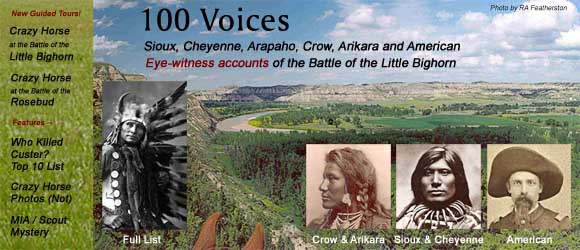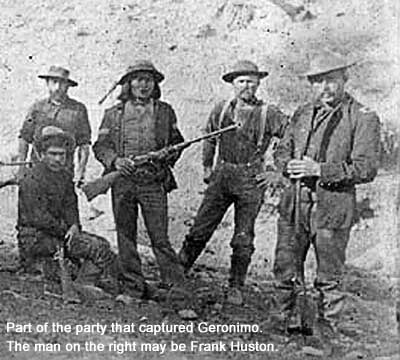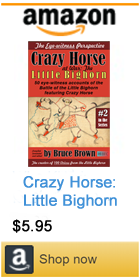|
|||||||
Bruce Brown's 100 Voices... Frank Huston's Story of the Battle
FRANK HUSTON'S COMMENTS
"I will not hint, nor will I talk, but as Hoffman knows, I was one of the bunch that helped Rain (Rain In The Face) escape from the guard house. I saw Tom Custer kick and slap Rain while troopers held him a prisoner, and I got out of the Post Trader's before they came back to get me. I was a squaw man, yes; but I was not present at the Little Big Horn. I was 50 miles away headed thereto. But O -- how I would have liked to have been there! Yet as a matter of fact, there were white men there; not with the Sioux, but with other nations present. Put yourself in their place. Would you, then or now, acknowledge it? "As to prisoners; from '66 to '81, with some time off, I was mainly in tepees, and in all that time I never saw a grown male white taken prisoner, nor heard of one. There might have been, and probably were some, but I relate my experience as it was. "I judge that Reno (as one of his 'skippers' later told me) became rattled, but he did not stampede, and saved his command by pushing up the bluffs. That the battalion did stampede I concede, but our people (i.e. the Indians) had 'put the fear of God' into the men. Reno's record in the War between the States refutes any accusation of cowardice; but he was ignorant of Indian methods of fighting and made a convenient 'goat'. "Among the Sioux, Horse (i.e. Crazy Horse) ranked as senior (like a ranking Major General) of the four principal chiefs of an organization equivalent to the Medicine Lances of the Cheyennes. That is to say, he was of equal rank with the late Roman Nose, Red Cloud, Spotted Tail and others. He [Crazy Horse] wore the long white 'stole' over his shoulders as insignia, and also to tie himself to his planted lance in a fight to the death. "Bull (i.e. Sitting Bull) I think was a 'Water Pourer': only seven of them at a time amongst all the Lakotah Nation -- equivalent to Cardinals of the Church of Rome. Magpi Luta (i.e. Red Cloud) also took that degree and became a sort of Richelieu. "I find almost no one with a proper understanding of the attitude of Bull et al. As Tatanka (i.e. Sitting Bull) said: 'We ask only to be let alone.' Kettle (i.e. Black Kettle) said the same). 'All we wish is that you yellow-faces keep out of our country. We don't want to fight you. This is our country. The Great Spirit gave it to us. Keep out and we will be friends.' "While I believe that white men were with the Indians at the Little Big Horn, they were not with the Sioux, because Bull was 'peculiar' and at such times objected forcibly to the presence even of half-breeds or 'breeds' as we termed them. "The only purely white man I ever knew that really got under the Indian's skin and understood him, his point of view and reasoning, was Philo Clark of the 2d Cavalry. Crook did too; but Crook had Injun blood in him. Frank North understood how to handle them, but even he could not 'stand in their cumpaws' and shed his white preconceptions. [Frank] Grouard, of course, was part Canuck, part Kanaka and practically an Indian himself. I think he married one of Bull's daughters, but that did not prevent Bull's chasing him out when hostilities prevailed. Bridger did also, and so did the negro Beckworth, but I never met either of them. "Although somewhat addicted to snobbishness, yet I hate pretense, and George Custer has always been anathema to me. His massacre of Kettle's band on the Washita was a fitting supplement to Sand Creek where Kettle's first abuse by whites occurred." HUSTON'S FURTHER COMMENTS It is well to remember that the Minnesota affair was yet vivid in the minds of the people, and I doubt if any expected or hoped that the participants in the Custer fight would be treated otherwise than Little Crow's people were. That will account for many conflicting stories, denials, and minimizing of important details. Then the desire to placate the conquerors' was strong. Bull had enemies. What strong successful man has not? Interpreters often rendered "Big Warrior" as "Big Chief." Even Rain was never made a chief, but he did have all the influence of one, but not the power. The word "Chief" is too loosely used by whites. Leaders or heads of bands. were called Chiefs, by whites who were ignorant of the fact that these men were officers of the military orders and as such were chiefs. English rendition of word more comprehensive than Indian. Friendship was a stronger and closer tie than blood kinship, and it is a human trait to exalt a friend and conceal any possible incriminating acts of his, as also to deprecate an enemy, personal or general. This was done. After a while they got "fed up" on questions and would say what they thought the questioners would be pleased at, or tell any old thing to be rid of the impositive and everlasting queries. This had a greater bearing on the stories than people realize. Low Dog's casualty list, I think. only covers his own band. As to Bull's cowardice: he had as much place in a battle as Gen. Pershing would have had in a trench raid. His job was to make medicine to make the hearts and actions of his people "strong" during a fight as well as before. As a Strong Heart he had fought well and taken horses and scalps. After he became,a Medicine Man, he was to fight only in great emergencies. The Hi-yi-yi -- was the Cheyenne war cry. "Hi-yi-yi" like a scared kioodles yipping. Man! but it could stir ones blood. Crow King's account (mentally edited by him) is good except that they knew the Yank command had divided. This I doubt as I was told Custer's attack was a surprise. Rain told me and as he and I were friends I believe it. Crow's statement that if Custer had joined Reno the Indians would have been whipped is all "bullcon", told to please the querist. Not an Indian there but was confident that Bull's prophesy would be fulfilled and that they could lick all hell and creation. Hump's story I like best as to the Custer end; "no man could give any account of it." "They never slacked up-they made a finish of it." They did. You have been in battle. If a melee, then you know how everything is confusion like a disturbed ants nest, or a pig in a girl's boarding school, "only more so." If you go into a fight, highly confident of your ability to whip ten times your weight in wounded wild cats and suddenly find the shoe is on the other foot, then you may get a true idea of "Le Grand Poseur" and his command. I had the esteemed pleasure once of hearing him remark "No enlisted man should ever be made an officer; they bring the barrack room air into the quarters." Had he said "some" I would have concurred. Consider Mike Sheridan, Maj. O'Hara, et al. Gall, I class as our Jackson and your Grant, but not steadfast. He was jealous of Bull. Put Horse [Crazy Horse] as Hancock, not quite equal to Stuart. I note that the Cheyenne are classed as a Sioux "tribe". Wrong. Newspaper and scientific sharps statements doubtless. I think that some chiefs wanted to remain and fight Terry but that Bull said that the signs were inauspicious, so they packed up and got. Scouts and others hastening to join, came in and reported "heap many" coming, with two bang guns. ("They speak twice": artillery using shells). The Blackfeet Sioux were a small unimportant band that must not be confounded with the Black foot Nation. The same holds good regarding the Gros Ventres (Grow Vaunts). One bunch were Arapajo stock, the other, around Ft. Berthold, were Crows. G. Vt. of Prairie were the Blue Cloud stock. My theory is that the Arapajo were descendants of Phoenecians, Tirepihu-trader: could write a book on it. I believe the Cheyenne of Norse ancestry, but all pure theory. Europe and Asia uniting with aboriginal America to form the Indian, lots of corroborative indications towards it. I believe the Maridans Welsh basis, either Ericson or Madoc: prefer former as allied blood of Sanier(?) i.e. Algonquin. Much to support these theories. The Custer Myth: A Source Book of Custerania, written and compiled by Colonel W.A. Graham, The Stackpole Co., Harrisburg, PA 1953, p 79 - 80
Although Frank Huston was not at the Battle of the Little Bighorn (by his own account, he was "50 miles away and headed thereto"), his story of Rain In The Face's abuse by Tom Custer provides an eye-witness account of an important background event to the battle. Similarly, he knew and many of the principles and his comments about them, though often highly subjective, are likewise based on first-hand knowledge. His theories on the Phoenecians are his own. * * * W.A. Graham wrote of Frank Huston: "The late Frank H. Huston, whose comments on the 1881 stories of Low Dog, Hump and Crow King appear below, knew more about Indians and in particular, the Sioux - than anyone with whom I ever came in contact. And he knew more about the battle of the Little Big Horn too, than anyone could know without having been there, or was very closely associated with the Indians who were there. "My acquaintance with him was largely through correspondence during the early 20's. He had been a frequent corresponding contributor to the "Camp Fire" section of the Adventure Magazine, which during the reign of Arthur Sullivant Hoffman as Editor, was easily the most valuable and informative debating ground for disputed points of western history to be found in any magazine. Hoffman was convinced, because of some of Huston's observations, that he was in the hostile camp during the battle, though he, of course, understandably enough, would not admit it. "His personal history was a sad one. A native of Richmond, Virginia, during the last years of the Civil War he was a youth doing a man's work in the ranks of Lee's army. When Richmond fell, his Mother, who had remained at the family home, was assaulted and beaten with rifle butts by drunken soldiers of Weitzel's command, who were the first to enter the city. She died as a result of her injuries and her son was never able even to locate her grave. "That this shocking tragedy embittered him is easy to understand; and shortly after the cessation of hostilities, he made his way West without taking the oath of allegiance, and joined the Sioux, determined "to even the score against the blue bellies," as did many others." -- B.B. |
|||||||




 IN MARCH, 1925, he [Frank Huston] wrote me: "I differ with you on the point that the 'cognoscenti' of those days owe it to posterity to become garrulous. They were not exactly Sunday School scholars, you know...
IN MARCH, 1925, he [Frank Huston] wrote me: "I differ with you on the point that the 'cognoscenti' of those days owe it to posterity to become garrulous. They were not exactly Sunday School scholars, you know... 







